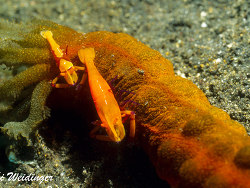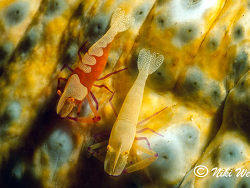Info
Zenopontonia rex (Kemp, 1922)
Zenopontonia rex is widespread in the Indo-Pacific and is one of the more colorful shrimps. It forms commensal relationships with various species of nudibranchs and sea cucumbers (Holothuria), but the adult shrimps are most commonly found as a pair on the nudibranch "Spanish dancer" (Hexabranchus sanguineus).
As they are quite shy, they are not always the easiest shrimps to photograph as they often hide under their host. Zenopontonia rex was first described by Bruce in 1967 from specimens collected from Hexabranchus sanguineus in Zanzibar and Mozambique. Bruce found that smaller specimens are found on sea cucumbers, while the larger specimens live on Hexabranchus sanguineus.
The shrimp feeds on organic material and small marine organisms that are disturbed and adhere to their host's mucus when their host moves. They have also been documented to eat parasitic organisms from their host, making their relationship with the host more of a symbiotic one.
They have also been documented to eat eggs from their sea cucumber hosts, which is a parasitic behavior. However, given their size, they are unlikely to cause much damage to the host's reproductive capabilities, but sometimes relationships underwater are complex and difficult to define.
Extremely variable in color and pattern, usually matching the animal on which it lives. Although their colors vary, the usual body base color is red with white on the carapace and tail. However, some specimens have an orange-red color and others are completely covered with white spots. It is also very rare to find yellow specimens.
The claws and legs also vary considerably between translucent, orange and red and are covered with small white dots. The tips of the claws are generally purple, as are the elbows.
The shrimp benefit from the relationship by gaining protection from their hosts, which are venomous, and although the host receives no known benefit, they are not harmed either.
May be confused with Zenopontonia soror, but this is found exclusively on various starfish.
Synonyms:
Periclimenes (Periclimenes) rex Kemp, 1922
Periclimenes imperator Bruce, 1967
Periclimenes rex Kemp, 1922
Zenopontonia rex is widespread in the Indo-Pacific and is one of the more colorful shrimps. It forms commensal relationships with various species of nudibranchs and sea cucumbers (Holothuria), but the adult shrimps are most commonly found as a pair on the nudibranch "Spanish dancer" (Hexabranchus sanguineus).
As they are quite shy, they are not always the easiest shrimps to photograph as they often hide under their host. Zenopontonia rex was first described by Bruce in 1967 from specimens collected from Hexabranchus sanguineus in Zanzibar and Mozambique. Bruce found that smaller specimens are found on sea cucumbers, while the larger specimens live on Hexabranchus sanguineus.
The shrimp feeds on organic material and small marine organisms that are disturbed and adhere to their host's mucus when their host moves. They have also been documented to eat parasitic organisms from their host, making their relationship with the host more of a symbiotic one.
They have also been documented to eat eggs from their sea cucumber hosts, which is a parasitic behavior. However, given their size, they are unlikely to cause much damage to the host's reproductive capabilities, but sometimes relationships underwater are complex and difficult to define.
Extremely variable in color and pattern, usually matching the animal on which it lives. Although their colors vary, the usual body base color is red with white on the carapace and tail. However, some specimens have an orange-red color and others are completely covered with white spots. It is also very rare to find yellow specimens.
The claws and legs also vary considerably between translucent, orange and red and are covered with small white dots. The tips of the claws are generally purple, as are the elbows.
The shrimp benefit from the relationship by gaining protection from their hosts, which are venomous, and although the host receives no known benefit, they are not harmed either.
May be confused with Zenopontonia soror, but this is found exclusively on various starfish.
Synonyms:
Periclimenes (Periclimenes) rex Kemp, 1922
Periclimenes imperator Bruce, 1967
Periclimenes rex Kemp, 1922







 Ole Johan Brett, Norwegen
Ole Johan Brett, Norwegen






























